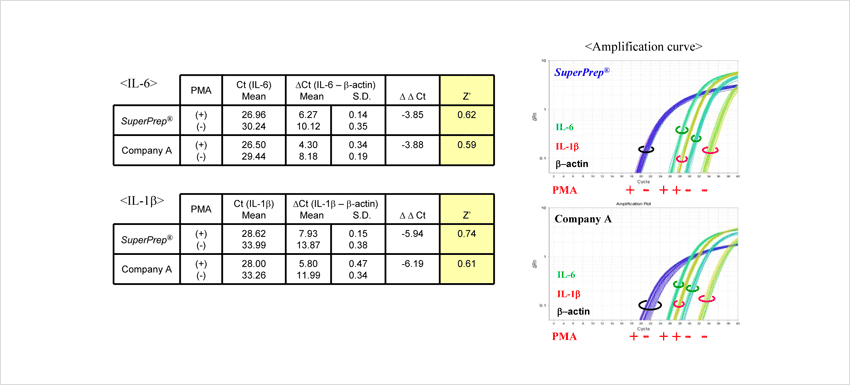- HOME
- Cell lysis & cDNA Synthesis kit for real-time PCR (For cultured cells) SuperPrepTM Cell Lysis & RT Kit for qPCR/
SuperPrepTM Cell Lysis Kit for qPCR
-
Cell lysis & cDNA Synthesis kit for real-time PCR (For cultured cells)
SuperPrepTM Cell Lysis & RT Kit for qPCR/
SuperPrepTM Cell Lysis Kit for qPCRCode No. SCQ-101 100 reactions [ 50 µL per reaction ] / Code No. SCQ-201 100 reactions [ 50 µL per reaction ]
*This product is not available in the U.S. and Europe.
DESCRIPTION
-
-
SuperPrep™ Cell Lysis & RT Kit for qPCR (Code No. SCQ-101) consists of "Lysis Reagents" and "RT Reagents" for synthesis of cDNA templates for real-time PCR assays. "Lysis Reagents" prepares cell lysates containing RNAs that can be used as templates for reverse transcription. "RT Reagents" contains reagents for reverse transcription, optimized for efficient cDNA synthesis from crude lysates. The synthesized cDNA can be applied to real-time PCR directly. This assay system is suitable for high-throughput assays.
SuperPrep™ Cell Lysis Kit for qPCR (Code No. SCQ-201) is an option of "Lysis Reagents". The cell lysate prepared by "Lysis Reagents" can be applied to one-step real-time PCR.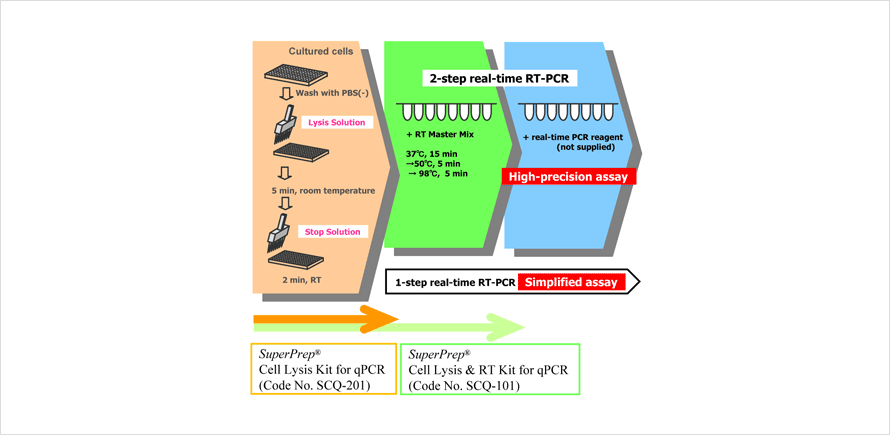
-
Features
- ・ RNA purification is not necessary.
- ・ High-quality cDNA can be obtained from cell lysates.
- ・ Reduction of dispersion on high-throughput assay.
- ・ Various real-time PCR regents can be applied.
Details
Applications
<SuperPrep™ Cell Lysis & RT Kit for qPCR>
cDNA synthesis for real-time PCR from mammalian cultured cells (SCQ-101)
total RNA synthesis for real-time PCR from mammalian cultured cells (SCQ-201)
Storage condition
Store at -20ºC
Components
The reagent includes the following components for 20 reactions (SCQ-101S, SCQ-201S) or 100 reactions (SCQ-101, SCQ-201).
SCQ-101S and SCQ-101 contain two separate packages named "Lysis Reagents" and "RT Reagents", respectively. All reagents should be stored at -20ºC.
Table 1.SuperPrep™ Cell Lysis & RT Kit for qPCR (SCQ-101, SCQ-101S)
| <Lysis Reagents> | SCQ-101 | SCQ-101S (SAMPLE) |
|---|---|---|
| Lysis Solution | 5.5 mL | 1.1 mL |
| gDNA Remover | 33 µL | 6.6 µL |
| Stop Solution | 1.1 mL | 220 µL |
| <RT Reagents> | SCQ-101 | SCQ-101S (SAMPLE) |
|---|---|---|
| 5 x RT Master Mix | 860 µL | 172 µL |
| 5 x RT Master Mix no-RT control | 86 µL | 17 µL |
| Nuclease-free Water | 2 × 1.7 mL | 680 µL |
Table 2.SuperPrep™ Cell Lysis Kit for qPCR (SCQ-201, SCQ-201S)
| SCQ-201 | SCQ-201S (SAMPLE) | |
|---|---|---|
| Lysis Solution | 5.5 mL | 1.1 mL |
| gDNA Remover | 33 µL | 6.6 µL |
| Stop Solution | 1.1 mL | 220 µL |
| RNase Inhibitor | 1.1 mL | 220 µL |
Application Data
Example 1.High-quality cDNA can be obtained from cell lysates.
The optimized lysis solution efficiently inhibits RNA degradation during treatment. RNA in the lysate is stable on ice for at least 2 h. High-quality cDNA can be synthesized using highly efficient reverse transcriptase "ReverTra Ace™" with low contamination of genomic DNA because of preceding DNase I treatment. The reverse transcriptase is supplied as a master mix reagent containing optimally mixed primers (random and oligo dT) to achieve effective cDNA synthesis.
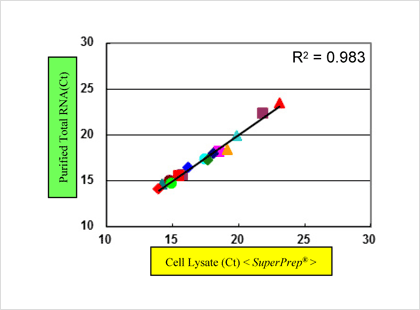
Comparison of the efficiency with purified RNA
SuperPrep™ Cell Lysis & RT Kit for qPCR (Code No SCQ-101) synthesized cDNA using the lysate from 2.5×104 HEK293 cells in a 40 µL reaction. cDNA was synthesized using 66.6 ng of total RNA, corresponding to 2.5×104 HEK293 cells, using a cDNA synthesis kit (ReverTra Ace™ qPCR RT Master Mix [Code No. FSQ-201]) in a 40 µL reaction. Fifteen housekeeping genes were then analyzed by SYBR® Green real-time PCR using the synthesized cDNA. High correlation was observed between the two methods. The method using SuperPrep™ facilitated the expression analysis by real-time PCR without time-consuming RNA purification steps.
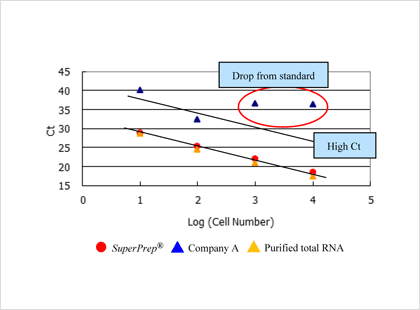
Evalution of efficiency for expression analysis of cells with high RNase activity
Expression analysis using a lysate from U937 cells is difficult because of high RNase activity. In this experiment, the lysates (8 µL) from 1×104, 1×103, 1×102 and 1×101 cells were used. β-actin genes were analyzed by SYBR® Green real-time PCR assay using cDNA synthesized from the lysates in 40 µL reaction. The same experiments were performed using two similar systems (SuperPrep™ and another company's product [Company A]) and conventional method using corresponding amounts of RNAs. SuperPrep™ showed successful amplification, comparable to the conventional method.
The cells tested by this systems.
| Call Name | Adherent/ Non-adherent |
Species | Remarks | |
|---|---|---|---|---|
| 1 | A431 | Adherent | H.sapiens | epidermoid carcinoma cell line |
| 2 | C2C12 | Adherent | M. musculus | myoblast cell line |
| 3 | Caco-2 | Adherent | H.sapiens | colon adenocarcinoma cell line |
| 4 | CHO-K1 | Adherent | C. griseus | ovary cell line |
| 5 | COLO205 | Non-adherent | H.sapiens | colon adenocarcinoma cell line |
| 6 | DLD-1 | Adherent | H.sapiens | colon adenocarcinoma cell line |
| 7 | HCT-15 | Adherent | H.sapiens | colon adenocarcinoma cell line |
| 8 | HDF | Adherent | H.sapiens | primary foreskin fibroblasts (primary cell) |
| 9 | HEK293 | Adherent | H.sapiens | embryonic kidney cell line |
| 10 | HeLa S3 | Adherent | H.sapiens | cervix carcinoma cell line |
| 11 | HepG2 | Adherent | H.sapiens | hepatocellular carcinoma cell line |
| 12 | HUVEC | Adherent | H.sapiens | umbilical vein endothelial cells (primary cell) |
| 13 | Jurkat | Non-adherent | H.sapiens | T lymphocyte cell line |
| 14 | K562 | Non-adherent | H.sapiens | myelogenous leukemia cell line |
| 15 | KUSA-A1 | Adherent | M. musculus | bone marrow stromal stem cell line |
| 16 | L929 | Adherent | M. musculus | aneuploid fibrosarcoma cell line |
| 17 | MCF7 | Adherent | M. musculus | breast adenocarcinoma cell line |
| 18 | Neuro2a | Adherent | M. musculus | neuroblastoma cell line |
| 19 | NIH-3T3 | Adherent | M. musculus | embryo fibroblast cell line |
| 20 | PC12 | Adherent | R. norvegicus | adrenal pheochromocytoma cell line |
| 21 | rMSC | Adherent | R. norvegicus | bone marrow stromal stem cells (primary cell) |
| 22 | THP-1 | Non-adherent | H.sapiens | acute monocytic leukemia cell line |
| 23 | U937 | Non-adherent | H.sapiens | leukemic monocyte lymphoma cell line |
Example 2.Stability test of the cell lysates.
cDNA were synthesized from lysates that had been left on ice for 0–24 h after lysing of 4×104 HeLa and U937 cells using SuperPrep™. β-actin genes were detected using TaqMan™ real-time PCR assay with THUNDERBIRD™ Probe qPCR Mix (Code No. QPS-101). The results were compared with that from the other company’s system (Company A). The results suggest that the RNA in the cell lysates is stable for at least 2 h. Lysates from U937 cells showed higher RNase activity than the other cells and tended to deteriorate in storage over 2 h.

NOTE:
RNase activity depends on the type and number of cells. The cell lysates should be placed on ice after preparation and cDNA should be synthesized immediately after preparing the lysates to minimize RNA degradation.
Example 3.Various real-time PCR reagents can be applied.
The synthesis cDNA can be used in various real-time PCR assay (TaqMan™ probe, SYBR® Green etc.).
In addition, the cell lysate can be applied to one-step real-time PCR reagents.
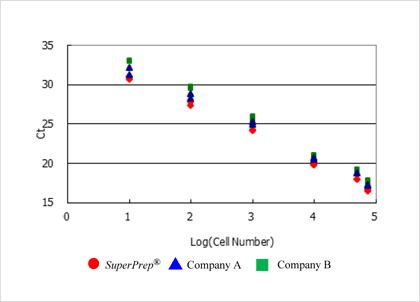
TaqMan™ Probe assay using cDNA synthesized from cell lysates prepared by SuperPrep™
cDNAs were synthesized using the cell lysates (8 µL) prepared from 7.5×104, 5×104, 1×104, 1×103, 1x102 and 1×10] HeLa S3 cells by SuperPrep™ in 40 µL reaction. β-actin genes were detected by various real-time PCR reagents with TaqMan™ real-time PCR assay. Successful amplifications were obtained from all reagents tested and the THUNDERBIRD™ Probe qPCR Mix tended to show a better Ct than the other tested methods.
Example 4.Evaluation of the assay variation
HeLa S3 cells were incubated with or without 100 nM phorbol 12-myristate 13-acetate (PMA) for 24 h after seeding at 2×104 cells/well in a 96-well culture plate. cDNA were synthesized from the lysates prepared from the cells washed with PBS(-). IL-6, IL-1β and β-actin genes were detected by TaqMan™ real-time PCR assay with THUNDERBIRD™ Probe qPCR Mix (Code No. QPS-101). After compensation of the Cts of IL-6 and IL-1β by that of β-actin, the ΔΔCt between with or without PMA and Z' factors* were calculated.
Z' factors from SuperPrep™ were superior to that from the other system (Company A).
*The Z' factor is a simple statistical parameter that is used to assess the quality of high-throughput screening (HTS) assays. A Z' score of ≥0.5 is generally considered to indicate good quality Z' can be calculated by the following formula.
Z'= 1-3 × [Δ Ct(+) standard deviation + Δ Ct(-) standard deviation]/| Δ Δ Ct|
